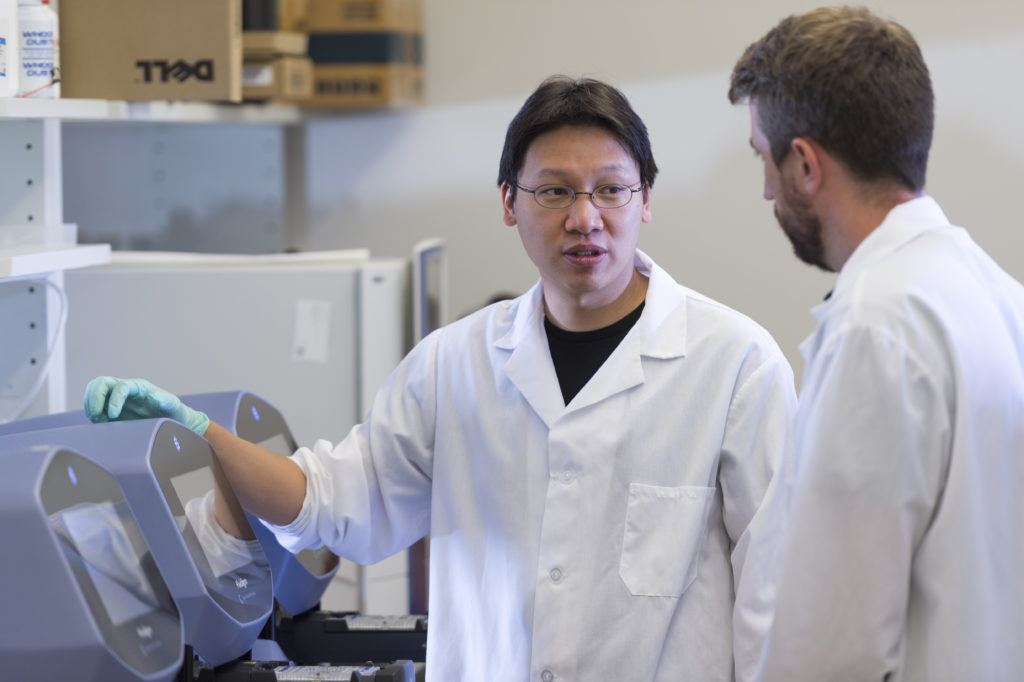For healthy development to occur — whether it be three weeks for a mouse or nine months for a human — embryos follow the lead of oscillating genes, which turn on and off in precise cycles and trigger different development milestones. Oscillating genes are conductors keeping time in a symphony of growth.
Scientists at the Morgridge Institute for Research have created a new way to study this virtually unknowable process in humans, using human stem cells in the lab. Their “clock in a dish” not only opens new research avenues, it provides a way to replicate developmental disorders to better understand their cause.
Reporting online in this week’s issue of Cell Reports, the team describes growing human stem cells that are programmed into a very early state, within the first month of development. Then, using CRISPR technology, they edited a specific gene known to be connected to timing so it would illuminate when expressed.
The result: The cells growing in a dish produce a burst of color every five hours, precisely when those faithful oscillating genes are repeating their instructions. This is the first confirmation of the exact timing of oscillating genes in early human development.
Li-Fang Chu, a scientist in the lab of Morgridge and University of Wisconsin-Madison stem cell research pioneer James Thomson, says most major oscillation findings to date have been with model organisms. The landmark paper 20 years ago described the oscillatory system in chickens, and following studies in zebrafish, mice and snakes have all added to knowledge.
“It is so early in the development states that in humans, there is no way you could even approach this process,” Chu says. “That’s why it was attractive for us to use stem cells to see if we can create it in the lab.”
The project focuses on a specific phase of development called somitogenesis — or the development of body segments — which takes place around 20 days of development. It is a period when the 42-44 pairs of somites are forming, and they develop one after the other in a very precise pattern over a period of about two weeks.
Targeting this phase was valuable for two reasons, Chu says. First, it gives them a very distinct time frame to study where there are recognizable physiological signatures, making it easier to match the genetic activity with the development. Second, a well-known genetic mutation occurs during this process that leads to a rare and debilitating disease.
The gene HES7 has been implicated in spondylocostal dysotosis (SCDO), where vertebrae improperly form and become fused together. Because past research highlighted the importance of HES7 to the segmentation clock, the lab made that gene the focus for CRISPR editing.
When HES7 is expressing normally in the experiment, the genes oscillate around every five hours as expected. But when introducing into HES7 a specific mutation associated with SCDO, the oscillation was completely disrupted. Essentially, the team recreated the conditions that cause SCDO and potentially other congenital skeletal defects.
“Like an airplane crash, we really don’t know what happened or what went wrong without the information in the black box,” Chu says. “I believe our system provides that black box.”
In real development, there are thousands of events happening simultaneously to create the complex organs in the body. To simplify their model, the researchers used only mesodermal cells — those responsible for creating tissue like bones, arteries and muscle. This gave the team a clearer perspective on what was happening with or without HES7 activation.
Developmental timing is one of the big questions being addressed in the Thomson Lab. Without a better understanding of the hard-wired timing within cells, clinical applications are limited. For example, many cell types take 100-300 days to become mature and functional in the body, making them unlikely candidates for cell therapy.
One of the keys to unraveling the mystery is looking at differences across species. Now that they have strong evidence of a roughly five-hour clock for human somite formation, they can compare it to known rates of 30 minutes for zebrafish, 90 minutes, 120 minutes for mice, and other species. These differences might ultimately offer clues on how to accelerate cell development for clinical benefit.
“If we understand in this case why mouse cells oscillate faster and human ones slower, we could apply that principle to other cell lineages and potentially speed things up,” he says.
A time-lapse video of the genetic signaling is available here: https://vimeo.com/356475749
The full paper is available here: https://www.cell.com/cell-reports/fulltext/S2211-1247(19)31006-X
scraped from https://www.newswise.com/articles/human-developmental-clock-mimicked-in-a-dish


